10% of Canada's greenhouse gas emissions are from crop and livestock production, excluding emissions from the use of fossil fuels or from fertilizer production.
The main gases emitted by agricultural activities are:
Conversely, agriculture helps slow climate change by storing carbon on agricultural lands. Storing, or sequestering, carbon in soil as organic matter, perennial vegetation, and in trees reduces carbon dioxide amounts in the atmosphere.
For more information on how to estimate farming greenhouse gas emissions and test ways to reduce these emissions, please visit: Holos software program.

Note: The size of the arrow indicates the relative magnitude of the emission or amount sequestered
Description – Sources of Greenhouse gas emissions from Canadian agriculture excluding CO2 emissions associated with energy use.
Figure shows the relative magnitudes of greenhouse gas emissions from four sources. From highest to lowest the emitters are CH4 from enteric fermentation, N20 from soils, N20 + CH4 from manure, and indirect emissions of N20. The figure also shows absorption of CO2 from the atmosphere by soils in approximately the scale of emissions by manure and indirect emission.
Agricultural activities inevitably result in multiple greenhouse gas emissions. Nitrous oxide emissions can originate directly from field-applied organic and inorganic fertilizers, crop residue decomposition, cultivation of organic soils, and from the storage of manure. Indirect nitrous oxide emissions can originate from nitrogen moved offsite such as from the volatilization and re-deposition of ammonia and from nitrogen leaching and run-off.
Methane emissions from agricultural sources in Canada are mainly a result of enteric fermentation in ruminant animals and from the anaerobic decomposition of stored manure. When organic matter in feed or manure decomposes under anaerobic conditions, a portion is released as methane.
Agricultural soils can either emit or absorb carbon dioxide. The difference is determined by the net effect of carbon dioxide absorption from the atmosphere by growing crops, and subsequent storage in the soil in the form of crop residues and soil organic matter, and emissions to the atmosphere via decomposition of crop residue and soil organic matter.
Agriculture emits all three greenhouse gases: carbon dioxide (CO2), methane (CH4), and nitrous oxide (N20). These gases differ, though, in their ability to trap heat; tonne for tonne, CH4 is more than 20 times as effective at trapping heat as CO2, and N20 is about 300 times as effective as CO2.
To compare the emissions of these gases on equal terms, we usually speak of CO2 equivalents (for example, N20 has 298 CO2 equivalents).
Agriculture also removes CO2 from the atmosphere - croplands and grazing lands can be managed to remove and store large amounts of CO2 as soil organic carbon.
Learn more about:
Carbon dioxide
Nature uses carbon to store energy. In the air, carbon exists mostly as carbon dioxide (CO2). Through photosynthesis, green plants invest the sun's energy in this CO2, building from it first sugars and then other energy-rich forms. Plant materials are then eaten by other organisms-microbes, cows, and humans, among others-who, in effect, burn the material back to CO2, using the solar energy it contains to live and grow.
Some of the energy-rich carbon materials can be stored for thousands or millions of years before being converted back to CO2. For example, soils contain vast amounts of carbon held in organic matter (humus), and the carbon in fossil fuels such as coal, oil and natural gas, which is solar energy trapped by plants eons ago.
Soil carbon
Farms and other ecosystems can be likened to batteries; building carbon stocks is like charging the battery and losing carbon like discharging it. On Canadian farms, carbon is stored mostly in the organic matter of soils. Changes in amounts stored depend on the rate of carbon coming in as plant litter, compared to the rate of carbon lost through decay.
If the rate of carbon input exceeds the rate of loss, carbon accumulates. This is called a carbon sink. If the rate of carbon added is less than the rate of the loss, carbon is depleted. This is called a carbon source.
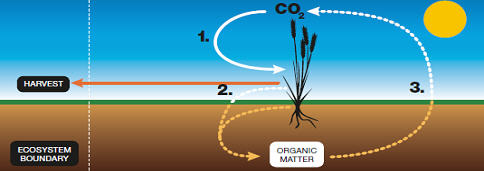
Description – The carbon cycle in an agricultural ecosystem
Figure shows a simplified Carbon system. Plants grow utilizing solar energy and atmospheric carbon dioxide. Plant tissue is removed from the system in the harvest or decomposes to add organic matter to the soil. Biological decomposition completes the cycle by returning CO2 to the atmosphere.
Soil Carbon is dynamic. Changes in the amount of carbon stored in soil organic matter depend on the relative rates of carbon input from plant litter and carbon emitted as CO2 via decomposition. If carbon inputs are greater than carbon loss, then the amount stored increases; if carbon input is less than carbon loss, the amount of carbon stored decreases. To increase stored carbon, practices must either:
- increase plant yield (photosynthesis);
- increase the proportion of fixed carbon added to soil; or
- slow the rate of organic matter decomposition.
What farmers can do to enhance the carbon sink
By managing soils for growing crops and raising livestock, the world's farmers are unconsciously, managing a soil carbon reservoir that is roughly equivalent to the total carbon that would be released after 100 years of fossil fuel burning at the current world rate. In recent years, the size of this immense carbon pool has changed very little.
Despite the apparent stability of this carbon reservoir, there is nothing permanent about any of the carbon which it contains, nor of the agricultural practices that promote this apparent stability.
Historically, when lands were first cropped, large amounts of carbon were lost because cultivation accelerated decay and removal of harvests meant less carbon was returned to soil. But today, farmers can rebuild some of the lost carbon through improved practices.
By increasing the amount of carbon stored in soils, these practices make soils more productive and resilient for use by future generations, while continuing to remove CO2 from the air.
If land management practices are changed in ways that increase the soil organic carbon, CO2 is effectively removed from the atmosphere and stored or 'sequestered' in the soil. The size of the 'sink' is increased. Farm practices that contribute to the carbon sink are:
- Reduction in tillage
- Restoring degraded land, improving pasture management
- Reducing fallow periods
- Adding animal manures to the soil
- Crop residue management
- Using legumes and/or grasses in crop rotations
- Converting marginal crop land to perennial grass or trees
- Using rotational grazing and high-intensity/short duration grazing
- Planting shrubs and trees as shelterbelts
- Restoring wetlands
In addition to sequestering carbon in the soil, these practices also increase soil productivity, enhance the quality of water running off or draining from agricultural land, and provide a more hospitable environment for wildlife inhabiting agricultural lands.
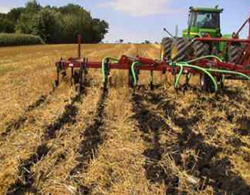
Conservation tillage
These practices can also help improve profitability. For example, minimum tillage increases energy efficiency by reducing machinery use. Improved crop varieties and crop fertilization can increase yields and soil carbon.
In Canada, one-quarter of a million farmers manage about 68 million hectares of land. Overall, these farmers have considerably improved the sustainability of their soil management practices on land used for crops and grazing.
In the year 2000, for the first time in Canada's history, agricultural soils sequestered more carbon than was emitted. This achievement was the result of a strong commitment to address soil degradation, in response to desertification risk and devastating erosion during much of the 20th century.
At current adoption rates of carbon sequestering agricultural practices in Canada, soil carbon accumulation can continue for at least until 2040. After this period, the continuance of sound farming practices that conserve the soil will maintain this sink rather than increase it.
Methane
Sometimes, when carbon-containing materials decay without sufficient oxygen, microbes produce methane (CH4) instead of carbon dioxide (CO2). On Canadian farms, this can occur in two situations: CH4 is produced inside the rumen (fore-stomach) of ruminant animals such as cattle and sheep through a bacterial process called enteric fermentation and in manure storage sites where high water content limits the entry of oxygen.
Enteric fermentation is the biggest source of CH4 from Canadian farms, is important because it enables livestock to convert otherwise indigestible materials such as grass and hay into usable energy.
Secondly, CH4 is released from manure storage sites, especially when manure is stored wet or as a slurry, because water prevents the entry of oxygen during decay.
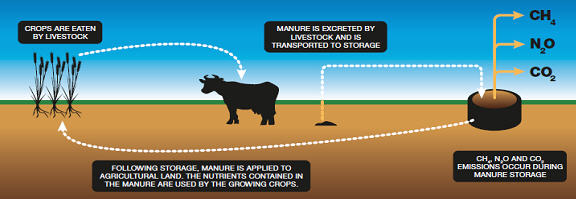
Description – Manure is an essential component of modern farming systems
Figure shows a nutrient cycle in a livestock operation and the loss of greenhouse gases from the system. Crops are eaten livestock, manure excreted and moved to a manure storage facility. CH4, N2O, and CO2 emissions are shown as losses to the system. From the storage facility, manure is spread on the land to be taken up by crops, thus completing the cycle.
Nutrients absorbed by crops are fed to livestock, which then excrete a portion of these nutrients in manure. Although manure represents a disposal liability to the farmers; it also represents a resource, as it contains valuable nutrients which can allow farmers to dispose of manure while providing nutrients to the soil.
Methane reductions
Scientists have long studied CH4 emissions from ruminants because such emissions mean the animal has not efficiently utilized the energy content of the feed to produce meat or milk. Through research, scientists have found effective ways of reducing these emissions. One way is to alter the diets of livestock: using high grain rations, adding fats or oils to rations, and using anti-microbial agents called ionophores, which reduce emissions at least for a time.
Feeding cattle higher quality forage-replacing grass hay with alfalfa, for example-can also reduce emissions of CH4 per unit of animal product. Scientists are also experimenting with compounds such as tannins, naturally present in some forages, as a way of suppressing CH4. Various other agents, including yeasts, organic acids, halogenated compounds such as chloroform, and possible vaccines are also being investigated, although in some cases their effectiveness in reducing emissions has not been widely confirmed.
Beyond these direct methods, CH4 emissions can be reduced indirectly by choosing management practices that enhance productivity:
- extending lactation periods of dairy cows
- using more efficient breeds
- improving reproductive performance
- increasing rates of gain in beef animals so they reach the market sooner
While these practices may not reduce emissions per animal per day, they can lower the amount of CH4 emitted per kilogram of milk or meat produced. Research has also shown that CH4 from manures can be reduced. Management practices that can be effective include: aerating manure, storing manure at low temperatures (below ground), removing manure from storage more frequently and using bedding material to improve aeration and composting manure (although the overall effectiveness of this practice may vary, in part because of possible emissions of N2O).
Another way to reduce emissions from manures is to remove CH4 using biological filters or, even better, to trap the CH4 and burn it as fuel, thereby offsetting fossil fuel otherwise needed.
Nitrous oxide
Nitrous oxide is another greenhouse gas (GHG) emitted from Canadian farms, accounting for about half the warming effect of agricultural emissions. This gas, familiar to us as laughing gas, is produced in nature by microbes as they process nitrogen in soils. All soils emit some nitrous oxide (N2O), but farm soils often emit more than others because of the nitrogen that is added to soil in the form of fertilizers, manures and other inputs.
Without these additional inputs to replace the nitrogen removed from farms in harvested grain, milk, meat, and other products, crop yields would soon decline. But as the amounts of added nitrogen increase so do potential losses into the environment, including losses of nitrogen to the air as N2O.
Typically, scientists assume that about 1% of the nitrogen added to farm fields is emitted as N2O, though this can vary widely with soil water content which is influenced by the hilliness of the land and soil clay content (for example, wetter soils tend to have higher emissions).
Aside from the N2O released directly from soils, farms can also produce indirect emissions. This is where N2O is produced outside the farm boundaries from nitrogen leached from fields or emitted into the air as ammonia gas.
This nitrogen, once lost from the farm, can find its way into adjacent environments where it can be converted and emitted as N2O. Although not produced on farms, this N2O is from nitrogen used on the farm; hence, it must be counted as farm-derived N2O. An illustration of how nitrogen is cycled in a farm environment is presented in the diagram below.
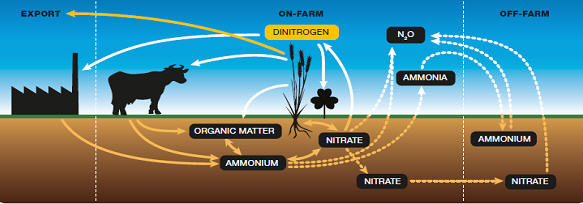
Description – Conceptual view of the nitrogen cycle on Canadian farms
Figure shows pathways of nitrogen compounds in a farm system. Movement includes transport within, import to, and export from the system. Nitrogen is imported to the farm in the form of ammonium and nitrate fertilizers. Nitrogen is exported from the system in the harvested crops and livestock products, ammonia and nitrous oxide losses to the air, and nitrates leached from the soil. Within the system, nitrogen from manure, fertilizer and soil organic matter is taken up by plants. Dinitrogen from the atmosphere may be fixed by legumes and be added to the soil as organic matter after plant residues decompose.
Nitrous oxide be produced at many points in the cycle. The term dinitrogen refers to the naturally-occurring nitrogen gas (N2) that is a major component of our atmosphere.
Nitrous oxide reduction
Since N2O is produced mostly from excess available nitrogen in soils, one way to suppress emissions of this gas is to apply fertilizer judiciously: adding just enough, at the right place and time, to meet crop demands, but avoiding excess amounts left over. This can reduce fertilizer costs to producers and reduce the amount of nitrogen lost through excess fertilizer application.
Fertilizer can be used more efficiently by:
- adjusting fertilizer rates to coincide with plant needs
- placing fertilizer near plant roots (but not too deep in the soil)
- applying fertilizer several times each year, rather than only once
- using slow-release forms
Similarly, using manure efficiently can also help limit N2O emissions-not only because less is released from the manure, but also because less fertilizer now needs to be used. Perhaps the most fundamental way of reducing N2O from manures is to alter feeding rations so that less nitrogen is excreted in urine and feces in the first place.
Other practices that can sometimes reduce N2O emissions from farms include:
- greater use of legumes as a nitrogen source
- use of cover crops (sown between successive crops) to remove excess available nitrogen
- avoiding use of summer fallow (leaving the land unplanted, with no crop nitrogen uptake, for a season)
- adjusting tillage intensity (sometimes, but not always, no-till practices can reduce emissions)
Most methods of reducing N2O emissions depend on improving the efficiency of nitrogen use on farms. Progress toward this aim has many other benefits:
- it reduces the cost of production because less fertilizer is used
- it saves on fossil fuel use (and hence CO2 emissions) because producing nitrogen fertilizer is energy intensive
- it lessens the amounts of nitrates, ammonia and other nitrogen pollutants entering the environment
Despite much progress, the nitrogen cycle on farms still results in the leakage of N2O and reducing these leaks remains a research priority.
Measuring emissions
Greenhouse Gas (GHG) emissions from farms are measured in part to honour international commitments; for example, Canada needs to provide reliable annual estimates of emissions from all important sources, including farms. However, emissions are also measured for scientific reasons: if you cannot measure emissions precisely, how can you know which of various practices best reduces emissions?
Without good estimates of emissions, how can you understand the underlying principles of GHG formation and release?
Measuring emissions of GHGs from farms is not easy; emissions come from many places on the farm: soils, animals of all kinds and machinery. Sometimes the gases seep slowly into the air; other times they spew in sporadic gusts.
To capture these emissions, scientists have devised a host of methods:
- small chambers placed on soils or large chambers housing cows
- instrumented towers downwind of fields or instrumented aircraft flying over farming regions
- methods that require patient analysis of carbon change in soils over tens of years
- measurements of carbon dioxide (CO2) in air, several times a second
- analysis of air in tubes buried in the soil, or from tubes hung high in the air on balloons
No method is perfect, but each has its role. By pooling results from all methods, scientists obtain reasonably good estimates of emissions and the factors that control them. This understanding is then usually captured in models-sets of mathematical equations that can predict GHG emissions for any set of conditions.
Such models are already widely used, but research continues to make them even more robust and reliable.
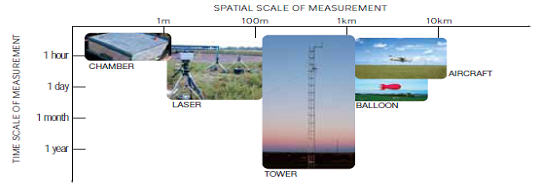
Description – The principle measurement techniques
Figure displays five measurement methods on a graph with two axes: Y axis is 'Time scale of Measurement' and X axis is 'Spatial Scale of Measurement'. Five gas measurement methods are located on the axes: Chamber, Laser, Tower, Aircraft and Balloon. Gas capture chamber technique is shown as appropriate for durations of an hour or less over areas of a metre or less. Laser technology is shown as appropriate for time periods of one hour to several days and over areas of one to 100m. Towers are used to measure over time periods ranging from one hour to more than a year and distances of 100 metres (m) to 1,000m. Aircraft can used to measure areas of one to ten kilometres and for parts of a single day. Balloons can be used for areas similar to aircraft but periods of time up to several days.
A variety of measurement techniques are used to estimate GHG emissions from Canadian agriculture. Each measurement technique is appropriate over a specific time and area, represented by the size of the photograph in the figure. By combining measurement techniques that cover different time frames and areas, scientists can estimate GHG emissions from areas smaller than one square metre to several square kilometres and from time frames of a few minutes to several years.
Source and Photo Credits: R. Desjardins, E. Pattey, Agriculture and Agri-Food Canada, Ottawa, Ontario and P.-L. Lizotte. McGill University, Montreal, Quebec
The amount of emissions we produce
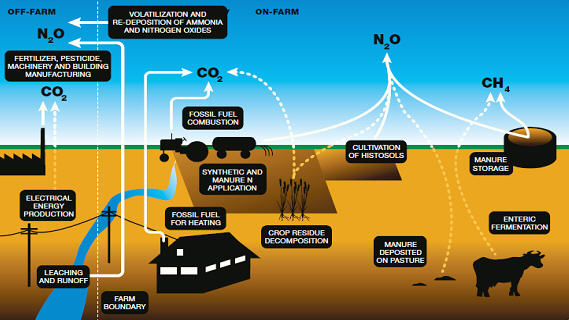
Description – On- and off-farm sources of greenhouse gas emissions
Figure shows sources of greenhouse gas emissions attributed to agriculture both on- and off-farm. On-farm emissions include methane emissions from manure, nitrous oxide emissions from manure, soil cultivation, crop residue decomposition and fossil fuel combustion, and carbon dioxide emissions from crop residue decomposition, and fossil fuel combustion. Off-farm emissions carbon dioxide emissions in the production of electricity, fertilizers, pesticides, machinery and building supplies, and nitrate and nitrous oxide losses from leachates.
In 2009, Canada produced 690 million tonnes of CO2 equivalents (Mt CO2e) from all sources, mostly as CO2 from energy use. Agriculture accounted for about 8% of these emissions (56 Mt CO2e), largely as CH4 (about two-thirds) and N2O (about one-third). This value does not include emissions from energy use; if these are counted, then agriculture accounts for roughly 10% of Canada's emissions.
As mentioned, farm soils remove substantial CO2 from the air when soils gain carbon under improved practices (about 12 Mt CO2e were removed in 2009). In fact, Canadian croplands have been a net sink for CO2 starting in about 1990. However, until recently the removals on croplands were offset by carbon losses from forests and grasslands recently converted to cropland. It is only since about 2000 that agricultural lands have been a net sink for CO2 when land use change is taken into account.
The annual total GHG emissions from farms in Canada have increased from 1990 to 2009 (See Figure below). The main driver is the increase in the beef and swine populations, although they have stabilized in recent years.
Since 2005, emissions from the agriculture sector have stabilized. Declines in emissions from livestock production are being offset by increases in emissions from crop production.
In 2009, a continued reduction in emissions from livestock production and a reduction in emissions from crop production resulted in an apparent decrease in emissions. However, this reduction may be insignificant in relation to inter-annual variability or climate variability from year to year.
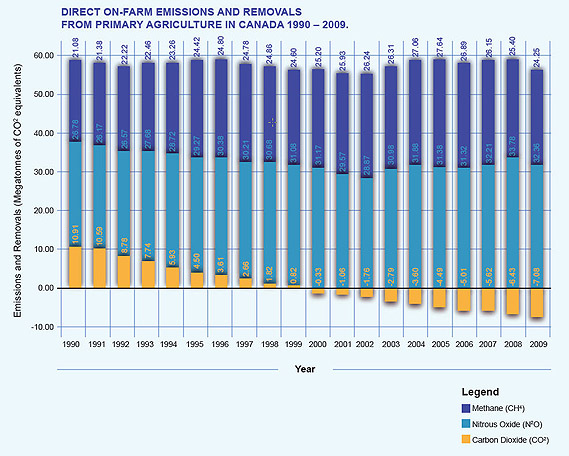
Description – Carbon dioxide, methane and nitrous oxide emissions and removals from 1990 to 2009 for Canadian agriculture
The chart shows emissions and removals (sources and sinks) in CO2 equivalents on the y axis and years on the x axis. Values below 0 are sinks (removals) and values above 0 are emissions. If the C sinks are taken into account as emissions offsets, net emissions in agriculture have declined relative to 1990.
| CO2 metric tonnes | N20 metric tonnes | CH4 metric tonnes | total metric tonnes | |
|---|---|---|---|---|
| 1990 | 10.91 | 26.78 | 21.08 | 58.77 |
| 1991 | 10.59 | 26.17 | 21.38 | 58.14 |
| 1992 | 8.78 | 26.57 | 22.22 | 57.57 |
| 1993 | 7.74 | 27.68 | 22.46 | 57.87 |
| 1994 | 5.93 | 28.72 | 23.26 | 57.91 |
| 1995 | 4.50 | 29.27 | 24.42 | 58.19 |
| 1996 | 3.61 | 30.38 | 24.80 | 58.79 |
| 1997 | 2.66 | 30.21 | 24.78 | 57.65 |
| 1998 | 1.82 | 30.68 | 24.86 | 57.36 |
| 1999 | 0.82 | 31.08 | 24.60 | 56.51 |
| 2000 | −0.33 | 31.17 | 25.20 | 56.05 |
| 2001 | −1.06 | 29.57 | 25.93 | 54.45 |
| 2002 | −1.76 | 28.87 | 26.24 | 53.36 |
| 2003 | −2.79 | 30.98 | 26.31 | 54.50 |
| 2004 | −3.60 | 31.88 | 27.06 | 55.33 |
| 2005 | −4.49 | 31.38 | 27.64 | 54.53 |
| 2006 | −5.01 | 31.32 | 26.89 | 53.20 |
| 2007 | −5.62 | 32.21 | 26.15 | 52.74 |
| 2008 | −6.43 | 33.78 | 25.40 | 52.74 |
| 2009 | −7.08 | 32.36 | 24.25 | 49.54 |
These estimates may not be perfectly accurate; all carry some uncertainty, in particular those for nitrous oxide (N2O). But they provide a reliable view of general trends and their uncertainty may slowly shrink with further research and gradually improving methods.
What will happen to GHG emissions in coming years? With growing demand for food and other products, livestock numbers and nitrogen additions may rise further, perhaps increasing CH4 and N2O emissions, unless new ways can be found to suppress them. Soil carbon gains (CO2 removals from the air), which have offset past increases in methane (CH4) and N2O emissions, may continue for some years, but not indefinitely; eventually, soil carbon approaches a maximum, typically a few decades after introducing new practices.
Even with good practices, therefore, it is hard to foresee farm GHG emissions falling appreciably over time. More important than reducing total emissions, however, may be finding ways to reduce emissions per unit of product. In the last 15 years, for example, dairy farmers have reduced CH4 emissions per kilogram of milk by about 13%, and similar trends are occurring with beef and pork.
International efforts
Climate change is one of the biggest issues facing countries around the world - the challenge for the agriculture and agri-food sector is to mitigate greenhouse gases (GHG) and adapt to the impacts of climate change without jeopardizing food security. Between 1990 and 2005, agriculture emissions in developing countries increased by 32% and agriculture and land use change (deforestation) currently represent about a third of global emissions. It is anticipated that agricultural emissions will continue to rise in response to demand for food and energy, especially in some developing countries.
The world will be challenged to meet the global demand for food, along with the demand to use increasing amounts of biomass for energy and other purposes (like building materials, chemicals etc.). About 1 billion people are currently malnourished and the number will grow as the world population is expected to approach 9 billion by 2050.
Climate change could compound the challenge by reducing the productive potential of some current food producing areas - there is growing concern about long-term food security, especially in least developed countries and parts of Africa.
The Food and Agriculture Organization provides an overview of the issues facing the agriculture and agri-food sector in a recent publication Coping with a changing climate: considerations for adaptation and mitigation in agriculture.
Concern about human interference with the global climate system led 192 countries to join an international treaty - the United Nations Framework Convention on Climate Change (UNFCCC) - more than a decade ago.
The Climate Convention has the goal of preventing "dangerous" human interference with the climate system by limiting emissions of greenhouse gases from human activities. It is one of three international agreements adopted at the 1992 "Rio Earth Summit." The others – the Convention on Biological Diversity and the Convention to Combat Desertification – involve matters strongly affected by agriculture and climate change.
One of the major accomplishments of the Convention is that it requires developed countries to provide annual inventories of greenhouse gas emissions from human activities related to the energy, transportation, industry, waste and agriculture and forest sectors (developing countries also are encouraged to carry out inventories).
Countries recognized that understanding the size of the problem is an important first step in finding solutions.
The annual inventories showed that global greenhouse gas emissions continued to rise through the early 1990s. In 1997, countries agreed to the Kyoto Protocol, an international agreement that sets legally binding greenhouse gas emission reduction targets for 37 developed countries and the European Union for reducing (GHG) emissions.
In total, the reductions amount to an average of 5% against 1990 levels over the five-year period 2008 to 2012.
Countries are currently negotiating a new international agreement in which all major GHG emitting countries will have emission reduction commitments. Most countries, including Canada, recognize that the agriculture and agri-food sector could contribute to the success of a future agreement. The sector could also benefit from a focus on approaches that enhance mitigation and adaptation actions, in particular by improving the efficiency and productivity of agriculture systems.
Given the expected increase in food demand over the next decades, managing emissions associated with food production will be important. Canadian farmers are relatively GHG-efficient and could be a leader in developing climate-smart agricultural systems.
More information on Greenhouse gases is available from the publication Better farming, better air: a scientific analysis of farming practice and greenhouse gases in Canada.
More information about Canada's action on climate change is available from Environment Canada.